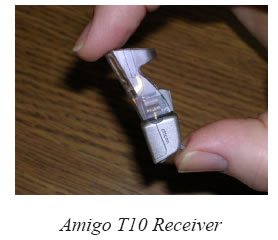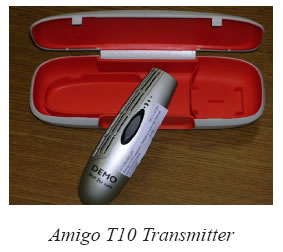|
Volume 16, No. 2, Spring 2008 |
Subscribe to AT Messenger Download PDF Viewer |
| PDF Version (for printing) Large Print (PDF) Text Version |
Loaner FM Equipment Donated to DATI
Kathleen Riley, MS, CCC-A, FAAA
Educational Audiologist
 Hearing aid technology has changed dramatically in the past five years with the inclusion of digital technology. More people with hearing loss have better, more beneficial access to the sounds around them. Multiple microphone arrays and noise suppression algorithms to hear better in noisy backgrounds are included in most mid-level and high-end hearing aids. However, these strategies have not yet conquered the difficult task of separating “noise” (unwanted or unimportant sounds) from the “signal” (speech that you are trying to understand). FM assistive technology remains the most effective way to gain access to speech in a noisy environment.
Hearing aid technology has changed dramatically in the past five years with the inclusion of digital technology. More people with hearing loss have better, more beneficial access to the sounds around them. Multiple microphone arrays and noise suppression algorithms to hear better in noisy backgrounds are included in most mid-level and high-end hearing aids. However, these strategies have not yet conquered the difficult task of separating “noise” (unwanted or unimportant sounds) from the “signal” (speech that you are trying to understand). FM assistive technology remains the most effective way to gain access to speech in a noisy environment.
 FM systems are comprised of a transmitter and microphone that are worn by the primary speaker and a receiver that is worn independently or coupled to the listener’s hearing aid. The signal (speech) is sent from the transmitter to the receiver via an FM radio signal. The FCC has assigned and protected certain frequencies for the sole use of FM assistive listening devices.
FM systems are comprised of a transmitter and microphone that are worn by the primary speaker and a receiver that is worn independently or coupled to the listener’s hearing aid. The signal (speech) is sent from the transmitter to the receiver via an FM radio signal. The FCC has assigned and protected certain frequencies for the sole use of FM assistive listening devices.
FM systems are used by adults in work settings, church assemblies and other group meetings, but the majority of FM systems in use today are used by children in the classroom. Soundfield FM systems use a transmitter worn by the teacher and a speaker on the wall that lets everyone in the classroom hear the amplified voice. Studies have shown these systems to improve attention and academic performance for a large number of students with and without hearing loss. Some students use a desktop receiver, which is about the size of a small lunchbox and is placed on or near the student’s desk. Other students use a personal receiver. That receiver can take the form of a headset, earbud, neckloop with a telecoil, or small “boot” that attaches to the hearing aid. Each configuration has its benefits and drawbacks, depending on the needs of the student and the classroom configuration.
DATI recently received two loaner FM systems from HLADE (Hearing Loss Association of Delaware). HLADE is a support group for persons with hearing loss with ties to the national organization, Hearing Loss Association of America. These systems are available for trial use before purchase by an individual, family, workplace or school system.
Audiologists are the trained professionals with expertise in coupling FM systems to existing hearing aids. At this time, DATI does not employ a full-time audiologist, but is working in conjunction with most local audiologists. Persons who are borrowing the loaner systems should contact their private audiologist to verify compatibility and configuration. Families with children ages 0-21 can also contact the itinerant teacher of deaf and hard-of-hearing students in their local school district to assist with understanding and using the system optimally. Additionally, families or school systems can contact the Statewide Coordinator of Services for Deaf and Hard-of-Hearing Students for support. These new loaner FM systems are manufactured by a leader in amplification, Oticon Corporation. The regional representative is also available for assistance as needed.

